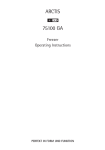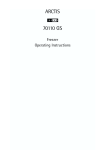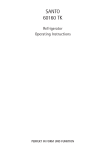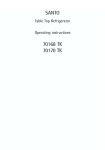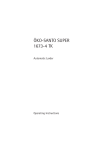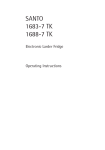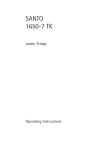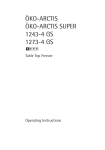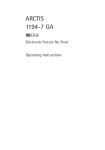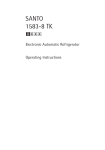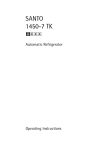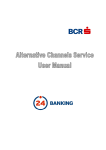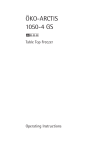Download Electrolux 70128 GS Operating instructions
Transcript
ARCTIS 70128 GS Freezer Operating Instructions Dear customer, Before placing your new refrigerator/freezer into operation please read these operating instructions carefully. They contain important information for safe use, for installation and for care of the appliance. Please keep these operating instructions for future reference. Pass them on to possible new owners of the appliance. These operating instructions are for use with several technically comparable models with varying accessories. Please observe the notes which apply to your model. Notes which are important for your safety or for the proper functioning of the appliance are stressed with a warning triangle and/ or with signal words (Warning!, Caution!, Important!). Please observe the following carefully. ☞1. This symbol guides you step by step in the operation of the appliance. 2. .... Supplementary information regarding operation and practical applications of the appliance appear after this symbol. Tips and notes concerning economical and environmentally sound use of the appliance are marked with the cloverleaf. The operating instructions contain instructions for the correction of possible malfunctions by the user in the section "What to do if ...". If these instructions should not be sufficient, please contact your local Service Force Centre. Printed on paper manufactured with environmentally sound proceses he who thinks ecologically acts accordingly... 2 Contents Important Safety Instructions . . . . . . . . . . . . . . . . . . . . . . . . . . . . . . . . . .4 Disposal . . . . . . . . . . . . . . . . . . . . . . . . . . . . . . . . . . . . . . . . . . . . . . . . . . .6 Appliance Packaging Information . . . . . . . . . . . . . . . . . . . . . . . . . . . . . . . . .6 Disposal of old Appliances . . . . . . . . . . . . . . . . . . . . . . . . . . . . . . . . . . . . . . .6 Remove transport packaging . . . . . . . . . . . . . . . . . . . . . . . . . . . . . . . . . . .7 Installation . . . . . . . . . . . . . . . . . . . . . . . . . . . . . . . . . . . . . . . . . . . . . . . .7 Installation Location . . . . . . . . . . . . . . . . . . . . . . . . . . . . . . . . . . . . . . . . . . .7 Your freezer needs air . . . . . . . . . . . . . . . . . . . . . . . . . . . . . . . . . . . . . . . . . .8 Reversing the door . . . . . . . . . . . . . . . . . . . . . . . . . . . . . . . . . . . . . . . . . . . .9 Electrical Connection . . . . . . . . . . . . . . . . . . . . . . . . . . . . . . . . . . . . . . . . . .10 Plug socket . . . . . . . . . . . . . . . . . . . . . . . . . . . . . . . . . . . . . . . . . . . . . . . . . .11 Description of the appliance . . . . . . . . . . . . . . . . . . . . . . . . . . . . . . . . . . 11 View of the appliance . . . . . . . . . . . . . . . . . . . . . . . . . . . . . . . . . . . . . . . . . 11 Prior to Initial Start–Up . . . . . . . . . . . . . . . . . . . . . . . . . . . . . . . . . . . . .12 Control panel . . . . . . . . . . . . . . . . . . . . . . . . . . . . . . . . . . . . . . . . . . . . .12 Temperature setting buttons . . . . . . . . . . . . . . . . . . . . . . . . . . . . . . . . . . . .12 Temperature display . . . . . . . . . . . . . . . . . . . . . . . . . . . . . . . . . . . . . . . . . . .13 Warning system . . . . . . . . . . . . . . . . . . . . . . . . . . . . . . . . . . . . . . . . . . . . . .13 Starting up and temperature regulation . . . . . . . . . . . . . . . . . . . . . . . . .14 FROSTMATIC . . . . . . . . . . . . . . . . . . . . . . . . . . . . . . . . . . . . . . . . . . . . . .15 FROSTMATIC Button . . . . . . . . . . . . . . . . . . . . . . . . . . . . . . . . . . . . . . . . . . .15 Switching off the appliance . . . . . . . . . . . . . . . . . . . . . . . . . . . . . . . . . . 16 Freezing and storing frozen food . . . . . . . . . . . . . . . . . . . . . . . . . . . 16 Storage Goods Symbol/Freezing Calendar . . . . . . . . . . . . . . . . . . . . . 18 Preparation of Ice Cubes . . . . . . . . . . . . . . . . . . . . . . . . . . . . . . . . . 18 Defrosting . . . . . . . . . . . . . . . . . . . . . . . . . . . . . . . . . . . . . . . . . . . . . . . . 18 Malfunctions. . . . . . . . . . . . . . . . . . . . . . . . . . . . . . . . . . . . . . . . . . . . . . 19 Cleaning and Care. . . . . . . . . . . . . . . . . . . . . . . . . . . . . . . . . . . . . . . . . . 20 Magnetic door seal. . . . . . . . . . . . . . . . . . . . . . . . . . . . . . . . . . . . . . 21 Energy Saving Tips . . . . . . . . . . . . . . . . . . . . . . . . . . . . . . . . . . . . . . . . . 21 What to do if ... . . . . . . . . . . . . . . . . . . . . . . . . . . . . . . . . . . . . . . . . . . . 22 Correcting Malfunctions . . . . . . . . . . . . . . . . . . . . . . . . . . . . . . . . . . . . . . . 22 Noises during Operation . . . . . . . . . . . . . . . . . . . . . . . . . . . . . . . . . . . . .23 Regulations, Standards, Guidelines . . . . . . . . . . . . . . . . . . . . . . . . . . . . .24 Technical terminology . . . . . . . . . . . . . . . . . . . . . . . . . . . . . . . . . . . . . . .25 3 Important Safety Instructions These warnings are provided in the interests of your safety. Ensure you fully understand them before installing or using the appliance. Your safety is of paramount importance. If you are unsure about the meaning of these warnings contact the Customer Care Department for assistance. Intended use • The freezer is intended for use in the home. It is suitable for the freezing of fresh food and storing frozen food, as well as for making ice. If the appliance is used for purposes other than those intended or used incorrectly, no liability can be accepted by the manufacturer for any damage that may be caused. • Alterations or changes to the freezer are not permitted for reasons of safety. • If you use the freezer in a commercial application or for purposes other than the freezing or frozen storage of foods, the manufacturer accepts no liability for any damages which may occur. Prior to initial start–up • Check the appliance for transport damage. Under no circumstance should a damaged appliance be plugged in. In the event of damage, please contact your supplier. • Ensure that the appliance does not stand on the electrical supply cable. Important: if the supply cable is damaged, it must be replaced by authorised service or qualified personnel using a special cable of the same type. Refrigerant The refrigerant isobutane (R600a) is contained within the refrigerant circuit of the appliance, a natural gas with a high level of environmental compatibility, which is nevertheless flammable. • Warning - During transportation and installation of the appliance, be certain that none of the components of the refrigerant circuit become damaged. • If the refrigerant circuit should become damaged: – avoid open flames and sources of ignition; – thoroughly ventilate the room in which the appliance is situated. Safety of children • Packaging (e.g. wraps, polystyrene) can be dangerous for children. There is a risk of suffocation! Keep packaging material away from children! • Please make old appliances unusable prior to disposal. Pull out the 4 Important Safety Instructions mains plug, cut off the mains cable, break or remove spring or bolt catches, if fitted. By doing this you ensure that children cannot lock themselves in the appliance when playing (there is risk of suffocation!) or get themselves into other dangerous situations. • Often children cannot recognise the hazards present in household appliances. It is therefore important that you ensure adequate supervision and never let children play with the appliance! Daily Operation • Containers with flammable gases or liquids can leak at low temperatures. There is a risk of an explosion! Do not store any containers with flammable materials such as spray cans, fire extinguisher refill cartridges etc in the refrigerator/freezer. • Bottles and cans must not be placed in the freezer. They can burst when the contents freeze, high carbonate content drinks can even explode! Never store lemonade, juices, beer, wine, sparkling wine etc. in the freezer. Exception: high alcohol content spirits can be stored in the freezer. • Do not put ice creams or ice cubes in the mouth immediately after removal from the freezer. Very cold ice can freeze to the lips or tongue and cause injury. • Do not touch frozen food with wet hands. Your hands could stick to the food causing skin abrasions. • Warning - Do not operate any electrical appliances in the refrigerator and/or freezer (e.g. electric ice cream makers, mixers etc.). • Warning - In order not to impair the function of the appliance, never cover or obstruct the ventilation openings. • Warning - Do not damage the cooling circuit. • Before cleaning the appliance, always switch off the appliance and unplug it, or disconnect from the electricity supply. • Placing frozen goods on the top of the appliance can lead to the accumulation of condensation in the cavity of the storage tray through contact with the cold. Electronic components are housed within this cavity. If condensation should drip onto these components, the appliance could be damaged by a short circuit. For this reason do not place frozen goods on top of the appliance. • When unplugging always pull the plug from the mains socket, do not pull on the cable. In case of malfunction • If a malfunction occurs on the appliance, please look first in the "What to do if ..." section of these instructions. If the information given there does not help, please do not perform any further repairs yourself. 5 • This product should be serviced by an authorised engineer and only genuine spare parts should be used. • Under no circumstances should you attempt to repair the appliance yourself. Repairs carried out by inexperienced persons may cause injury or serious malfunctioning. Contact your local Service Force Centre. Disposal Appliance Packaging Information All materials are environmentally sound! They can be disposed of or burned at an incinerating plant without danger. About the materials: The plastics can be recycled and are identified as follows: >PE< for polyethylene, e.g. the outer covering and the bags in the interior. >PS< for polystyrene foam, e.g. the pads, which are all free of chlorofluorocarbon. The carton parts are made from recycled paper and should be disposed of at a waste-paper recycling collection location. Disposal of old Appliances For environmental reasons, refrigeration appliances must be disposed of properly. This applies to your old appliance, and - at the end of its service life - for your new appliance as well. Warning! Before disposing of old appliances make them inoperable. Remove plug from mains, sever the power cable, remove or destroy any snap or latch closures. This ensures that playing children do not lock themselves inside the appliance (danger of suffocation!) or place themselves into other life-endangering situations. Disposal: • The appliance may not be disposed of with domestic waste or bulky refuse. • The refrigerant circuit, especially the heat exchanger at the back of the appliance, must not be damaged. • The symbol on the product or on its packaging indicates that this product may not be treated as household waste. Instead it shall be handed over to the applicable collection point for the recycling of electrical and electronic equipment. By ensuring this product is disposed of correctly, you will help prevent potential negative conse6 quences for the environment and human health, which could otherwise be caused by inappropriate waste handling of this product. For more detailed information about recycling of this product, please contact your local city office, your household waste disposal service or the shop where you purchased the product. Remove transport packaging The appliance and the interior fittings are protected for transport. 1. Pull off the adhesive tape on the left and right side of the door. 2. Remove all adhesive tape and packing pieces from the interior of the appliance. ☞ Installation Installation Location The appliance should be set up in a well ventilated, dry room. Energy use and efficient performance of the appliance is affected by the ambient temperature. The appliance should therefore – not be exposed to direct sunlight; – not be installed next to radiators, cookers or other sources of heat; – only be installed at a location whose ambient temperature corresponds to the climate classification, for which the appliance is designed. The climate classification can be found on the serial plate, which is located at the left on the inside of the appliance. The following table shows which ambient temperature is correct for each climate classification: Climate classification for an ambient temperature of SN +10 to +32 °C N +16 to +32 °C ST +18 to +38 °C T +18 to +43 °C If the refrigeration appliance is installed next to another refrigerator or freezer a clearance of 5 cm at the sides is required, in order to prevent the formation of condensation on the outside of the appliance. 7 Installation Your freezer needs air For correct operation this appliance must be located in a dry atmosphere, away from heat sources, e.g. cookers, radiators, boilers and direct sunlight. You should also ensure that air can circulate freely around the back and the top of the cabinet. There should be 100mm (4”) between the top of the cabinet and any overhanging kitchen furniture. Alternatively allow 50mm (2”) between the top of the cabinet and any overhanging kitchen furniture and a gap of 25mm (1”) on either side of the appliance. If your appliance is installed under a A/B continuous worktop, an air outlet 105 200 cm2 opening of at least 200 cm2 and a ventilation grille (A/B) matching the C worktop design should be installed at 570 the rear of the worktop. 550 93-103 The cut surfaces of the worktop (C) should be varnished to avoid swelling due to penetration of moisture. The appliance wall distance must be at least 30 mm and should be checked before the ventilation grille is inserted. Special accessories: A Ventilation grille, brown B Ventilation grille, white AEG36 8 Installation Reversing the door The side at which the door opens can be changed from the right side (as supplied) to the left side, if the installation site requires. Warning! When changing the side at which the door opens, the appliance must not be connected to the mains. Remove plug from the mains beforehand. the appliance slightly towards the ☞1. Tilt rear and prop it securely. 2. Unscrew the door hinge screws (K) and remove the hinge pin bracket (1). 3. Open the door a little way and take it out downwards. 1 K AEG97 4. Unscrew the upper pin (A) and screw it into place on the opposite side. 5. Fit the door into the upper pin (A) and close it. 6. Screw the hinge pin bracket (1) securely into place on the opposite side using the screws (K). A 12 AEG98 7. Unscrew the handle and refit it on the opposite side. Cover the holes left open with the plugs contained in the documentation pack. AEG75 9 Installation Electrical Connection Any electrical work required to install this appliance should be carried out by a qualified electrician or competent person. WARNING – THIS APPLIANCE MUST BE EARTHED The manufacturer declines any liability should these safety measures not be observed. 13 AMP Before switching on, make sure the electricity supply voltage is the same as that indicated on the appliance rating plate. The rating plate is inside, on the left. The appliance is supplied with a 13 amp plug fitted. In the event of having to change the fuse in the plug supplied, a 13 amp ASTA approved (BS 1362) fuse must be used. GREEN & YELLOW 13 AMP. FUSE Important The wires in the mains lead are coloured in accordance with the following code: Green and Yellow Earth Blue Neutral BROWN Brown Live BLUE CORD CLAMP As the colours of the wires in the mains lead of this appliance may not correspond with the coloured markings identifying the terminals in your plug, proceed as follows: 1.The wire coloured green and yellow must be connected to the terminal marked with the letter “E” or by the earth symbol or coloured green and yellow. 2.The wire coloured blue must be connected to the terminal marked “N” or coloured black. 3.The wire coloured brown must be connected to the terminal marked “L” or coloured red. 4.Upon completion there must be no cut, or stray strands of wire present and the cord clamp must be secure over the outer sheath. Warning! A cut-off plug inserted into a 13 amp socket is a serious safety (shock) hazard. Ensure that the cut-off plug is disposed of safety. 207 10 Plug socket The plug socket necessary for connection of your appliance to the electricity supply should be positioned so that it is possible to pull out the appliance plug. If your appliance is installed under a continuous worktop, the plug socket should be provided as shown. Alternatively a concealed spur socket fitted with a 13 A fuse may be fitted. If the socket is not accessible once the appliance is built in, the electrical installation must include suitable means of isolating the appliance from the mains (e.g. fuse, cut-out, current trip or similar with a minimum contact separation of 3 mm). 130 300 AEG44 Description of the appliance View of the appliance WÄRMER EIN/AUS 6 °C -16-18 -20 -22 -24 KÄLTER FROSTMATIC WARNUNG EIN AUS 1 Drawer (for storing frozen food and freezing fresh produce) 2 Drawer (for storing frozen food and freezing fresh produce) 3 Drawer (only for storage) 4 Drawer (only for storage) 5 Control panel 6 Rating plate The freezer has stops to prevent the drawers from falling out when fully extended. 11 To remove the drawers (e.g. for cleaning purposes), pull them out as far as the stops, lift and extract. Prior to Initial Start–Up ☞ Please clean the appliance interior and all accessories prior to initial start-up (see section: “Cleaning and Care”). Control panel 1 2 3 4 5 6 7 8 9 Pilot light (green) ON/OFF switch Temperature setting buttons (for warmer temperatures) Temperature display Temperature setting buttons (for colder temperatures) FROSTMATIC indicator light (yellow) Push button for FROSTMATIC Warning light (red) WARNING OFF button Temperature setting buttons The temperature is adjusted using the „+“ (WARMER) and „-“ (COLDER) buttons. These buttons are connected to the temperature display. • The temperature display is switched over from the display of the ACTUAL temperature (one light illuminated) to the display of the 12 Control panel DESIRED temperature (one light flashing) by pressing one of the two buttons, „+“ or „-“. • With each further press of one of the two buttons, the DESIRED temperature is adjusted by one display field. • If neither button is pressed, the temperature display automatically switches back after a short period (approx. 5 sec.) to the display of the ACTUAL temperature. DESIRED temperature means: The temperature that is required in the freezer, this can be adjusted to the temperatures shown in the display. The DESIRED temperature is indicated by a flashing light. ACTUAL temperature means: The temperature display indicates the temperature that is currently present in the freezer. The ACTUAL temperature is indicated by a continuously illuminated light. Temperature Display The temperature display can indicate several pieces of information. • During normal operation, the temperature currently present in the freezer (ACTUAL temperature) is displayed, the corresponding light illuminates. • If the temperature in the freezer is warmer than the display range of the temperature display, the red warning light flashes and all the lights in the temperature display are extinguished. • If the temperature in the freezer is colder than the display range of the temperature display, then the light for the lowest temperature (-24) continues to illuminate. • When the temperature is being adjusted, the temperature currently set flashes (DESIRED temperature). Warning system The warning system comprises of an optical warning light (red) and an acoustic warning tone. The red warning light and the warning tone signal an alarm if the temperature in the freezer compartment is too warm. 13 Temperature Warning The red warning light illuminates and the warning tone sounds if the temperature in the freezer compartment is warmer than -12°C. An increase in the temperature in the freezer compartment may be caused by - frequent or extended opening of the door; - storing large quantities of warm food; - a high ambient temperature; - a malfunction in the cooling system. 1. Switch off the warning tone by pressing the WARNING OFF button. The warning light and warning tone switch off automatically when the ACTUAL temperature in the freezer compartment drops again and returns to the range of the display. 2. Additionally operate FROSTMATIC by depressing the FROSTMATIC button for more than one second. The amber pilot light (5) comes on and the refrigerator motor runs continuously. 3. After the storage temperature has been reached, press the FROSTMATIC button again to switch off the FROSTMATIC function. The yellow light goes out. Note: when the appliance is switched on for the first time, the warning light and the warning tone signal an alarm because the necessary storage temperature in the freezer compartment has not yet been reached. ☞ Starting up and temperature regulation ☞1. Insert the plug into the plug socket. 2. Press ON/OFF button. The green mains pilot indicator illuminates. A warning tone sounds and the flashing red warning light indicates that the required storage temperature has not yet been reached. 3. Press the WARNING OFF button to switch off the warning tone. 4. Press either the „+“ (WARMER) or „-“ (COLDER) button. The temperature display switches over and the DESIRED temperature currently set flashes on the temperature display. 5. Set the required temperature by pressing the „+“ (WARMER) or „-“ (COLDER) buttons (see section "Temperature setting buttons"). The temperature display will immediately show the changed setting. With 14 each further press of one of the two buttons, the DESIRED temperature is adjusted by one display field. The temperature is fixed to -18°C. From a food safety point of view -18°C should be considered sufficiently cold for storing food in the freezer. 6. Once the required temperature has been set, after a short period (approx. 5 sec.) the temperature display will change and again indicate the current ACTUAL temperature inside the fridge. The display will change from flashing to continuous illumination. The compressor will start and then run automatically. Information! When the setting is changed, the compressor does not start immediately if automatic defrosting is currently taking place. Important! Wait until the freezer compartment has reached a temperature of -18°C before storing frozen food. FROSTMATIC FROSTMATIC button The FROSTMATIC function accelerates the freezing of fresh food and, at the same time, protects foodstuffs already stored from undesirable warming. 1. The FROSTMATIC function is switched on by pressing the FROSTMATIC button. The yellow light illuminates. If the FROSTMATIC function is not ended manually, the appliance electronics switch off the FROSTMATIC function after 48 hours. The yellow light goes out. 2. The FROSTMATIC function can be ended manually at any time by pressing the FROSTMATIC button again. The yellow light goes out. ☞ 15 Switching off the appliance switch off, press the ON/OFF button until the mains power light ☞ To extinguishes. If the appliance is not going to be used for an extended period: 1. Remove all deep-frozen packages as well as ice-trays. 2. Switch off the appliance by pressing the ON/OFF button until the mains power light extinguishes. 3. Remove the mains plug or switch off or disconnect the electricity supply. 4. Defrost freezer and clean thoroughly (see section: “Defrosting and Cleaning”). 5. Leave the door open to avoid the build up of odours. ☞ Freezing and storing frozen food You can use your freezer for freezing fresh food yourself. Important! • The temperature in the freezer compartment must be –18°C or colder before freezing food. • Please observe the freezing capacity given on the rating plate. The freezing capacity is the maximum quantity of fresh food that can be frozen within a period of 24 hours. If you wish to freeze food several days in a row, please observe a maximum capacity of only 2/3 to 3/4 of that on the rating plate. The quality of the food is best preserved when it is frozen right through to the core as quickly as possible. • Allow warm food to cool down before freezing. The warmth will cause increased ice formation and increase the power consumption. • Please note the maximum storage times specified by the manufacturer. • Thawed foods which have not been processed further (cooked into meals) may not under any circumstances be frozen a second time. • Containers with flammable gases or liquids can leak at low temperatures. There is a risk of an explosion! Do not store any containers with flammable materials such as, for example, spray cans, fire extinguisher refill cartridges etc in the refrigerator/freezer. • Bottles and cans must not be placed in the freezer. They can burst 16 Freezing and storing frozen food when the contents freeze, high carbonate content drinks can even explode! Never store lemonade, juices, beer, wine, sparkling wine etc. in the freezer. 1. To freeze the maximum quantity shown on the rating plate press the FROSTMATIC button 24 hours prior to freezing, or 4 to 6 hours for smaller quantities. Yellow display lights up. The FROSTMATIC button need not be pressed for freezing of small quantities. 2. All foods must be packed air tight prior to freezing, so that they do not dry out or lose their flavour, and so that no flavour contamination of other frozen goods occurs. Caution! Do not touch frozen food with wet hands. Your hands could stick to the food and cause skin abrasions. 3. Place the packed food in the drawers. Place food to be frozen in the appliance´s two top drawers (1) and (2) equipped with its own refrigerated shelves. Unfrozen food must not touch items already frozen, otherwise the frozen food could begin to defrost. Freezer drawers (3) and (4) should only be used for storage of frozen food. Place frozen foods in the drawers sorted by type, as far as possible. 4. Once the required storage temperate has been reached, press the FROSTMATIC button again. The yellow light goes out. The appliance’s electronics switch off the FROSTMATIC function automatically after 24 hours. The yellow light goes out. You can also end the FROSTMATIC function manually by pressing the FROSTMATIC button again. Tips: • The following are suited for the packaging of frozen goods: – freezer bags and polyethylene wraps; – special containers for frozen goods; – extra–thick aluminium foil. • The following are suitable for sealing bags and wrap: plastic clips, rubber bands or tape. • Smooth the air out of the bag before sealing; air makes it easier for the frozen food to dry out. • Make flat packages, because these freeze more quickly. • Do not fill containers for frozen goods to the brim with liquid or paste–like goods, because liquids expand during freezing. ☞ 17 Storage Goods Symbols/Freezing Calendar • The symbols on the drawers show different types of frozen goods. • The numbers indicate storage times in months for the appropriate types of frozen goods. Whether the upper or lower value of the indicated storage time is valid depends on the quality of the foods and pretreating before freezing. The lower value applies to foods with high fat content. Preparation of Ice Cubes the ice cube tray 3/4 full with cold water, place it in the freezer ☞1. Fill compartment and leave to freeze. 2. To loosen the frozen cubes, either bend the ice cube tray or hold it under running water for a few seconds. Important! Never try to free an ice tray that is frozen to the freezer compartment using pointed or sharp edged objects. Use the ice scraper supplied. Defrosting ☞ 18 During use and when the door is opened, moisture is deposited as frost inside the appliance, particularly on the evaporator melts. This frost must be removed from time to time using the soft plastic scraper supplied. Under no circumstances use hard or pointed objects for this purpose. The freezer should always be defrosted when the layer of frost has reached a thickness of approx. 4 millimetres. Defrost should be carried out once a year regardless of the amount of frost that has built up. A good time for defrosting is when the appliance is empty or contains only little food. Each temperature rise reduces the keeping qualities of your frozen food. Around 12 hours before defrosting your freezer, switch over to fast freeze to build up a low temperature reserve in the frozen food. Warning! • Do not use electrical heating appliances or any other mechanical or artificial devices to speed up the defrosting process. • Do not use defrosting sprays, they can be hazardous to your health and/or contain substances that damage plastics. Caution! Do not touch frozen food with wet hands. Your hands could stick to the food and can cause skin abrasions. 1. Switch on the FROSTMATIC function a few hours before defrosting to make sure frozen food remains sufficiently frozen. 2. Remove frozen food, wrap it in several layers of newspaper and store it, covered, in a cool place. 3. Switch off the appliance and unplug it, or pull the fuse or switch off the circuit breaker. 4. Remove all drawers except the bottom one. The bottom drawer serves as a practical container to collect the water from the thawing ice. Pull out the drawer and insert the plastic scraper in the special location to act as an extension channel to collect the defrost water. Tip: To speed up the defrosting process, place a pan with warm water in the appliance and close the door. Remove pieces of ice that have fallen before they completely defrost. 5. After defrosting, thoroughly clean the freezer compartment and interior fittings (see "Cleaning and Care" section). 6. Do not forget to switch the FROSTMATIC function off again. ☞ Malfunctions If the electronics in the appliance have detected a fault that prevents the ACTUAL temperature being measured, all the lights in the temperature display will flash. The appliance will continue to function using a backup program until your local Service Force engineer has repaired the appliance. 19 Cleaning and Care For hygienic reasons the appliance interior, including interior accessories, should be cleaned regularly. Warning! • The appliance must not be connected to the mains during cleaning. Danger of electrical shock! Before cleaning switch the appliance off and remove the plug from the mains, or switch off or disconnect from the electricity supply. • Never clean the appliance with a steam cleaner. Moisture could accumulate in electrical components and there is a danger of an electric shock. Hot vapours can lead to the damage of plastic parts. • The appliance must be dry before it is placed back into service. Important! • Ethereal oils and organic solvents can attack plastic parts, e.g. – lemon juice or the juice from orange peel; – butyric acid; – cleansers which contain acetic acid. Do not allow such substances to come into contact with appliance parts. • Do not use any abrasive cleansers. 1. Remove frozen food and wrap it in several layers of newspaper. Store it in a cool place, well covered. 2. Defrost the appliance prior to cleaning (see “Defrosting” section). 3. Switch off the appliance and unplug it. 4. Clean the appliance and the interior accessories with a cloth and lukewarm water with a little bicarbonate of soda added (5ml to 0.5 litres of water). 5. After cleaning wipe with fresh water and rub dry. 6. After everything is dry, switch to FROSTMATIC function and switch off the audible warning signal. Immediately replace the previously removed food in the freezer. When the red warning light goes out, turn the FROSTMATIC function off. Accumulation of dust at the condenser increases energy consumption. For this reason carefully clean the condenser at the back of the appliance once a year with a soft brush or a vacuum cleaner. ☞ 20 Magnetic door seal After opening and closing the door of your freezer you will not be able to open the door again immediately. This is because a vacuum will have developed inside, keeping the door closed until the pressures inside and outside the door have equalised. After a few minutes you can easily reopen the door. Energy Saving Tips • Do not install the appliance near boilers, radiators or other sources of heat. High ambient temperatures cause longer, more frequent operation of the compressor. • Ensure sufficient air circulation and exhaust at the appliance base and at the back wall of the appliance. Never cover air vent openings. • Do not place warm foods into the appliance. Allow warm foods to cool first. • Do not leave the door open any longer than necessary. • Do not set temperature any colder than necessary. • Check the storage temperature in the freezer on the temperature display. • Put frozen food in the fridge to defrost. The cold in the frozen food will then be used to cool the fridge. • Always keep the heat emitting condenser, the metal grille on the rear wall of your appliance clean. 21 What to do if ... Correcting Malfunctions A malfunction may be caused by only a minor fault that you can rectify yourself using the following instructions. Do not perform any other work on the appliance if the following information does not provide assistance in your specific case. Important! Repairs to refrigerators/freezers may only be performed by competent service engineers. Improper repairs can give rise to significant hazards for the user. If your appliance needs repairing, please contact your specialist dealer or your local Service Force Centre. If the freezer system has stopped working and the freezer is full, the reserve in the deep frozen food itself will give the food a hold over time of about 22 hours. Symptoms Appliance does not work, no pilot light is illuminated. Possible Cause Appliance is not switched on. Mains plug is not plugged in or is loose. Fuse has blown or is defective Socket is defective. Appliance cools too much. The freezer temperature is not sufficient, red light illuminates, temperature alarm signal sounds. Switch on the appliance. Insert mains plug. Check fuse, replace if necessary. Mains malfunctions are to be corrected by an electrician. Turn the temperature regulator to a warmer setting temporarily. Temperature is not proper- Please look in the “Initial ly adjusted. Start Up” section. Do not leave the door Door was open for an open any longer than necextended period. essary. Press the fast freeze switch. A large quantity of warm food placed in the appliPress the FROSTMATIC ance within the last 24 button. hours. Temperature is set too cold. The appliance is near a heat source. 22 Remedy Please look in the “Installation Location” section. What to do if... Symptoms Heavy build up of frost, possibly also on the door seal. Unusual noises. The compressor does not start immediately after changing the temperature setting. Possible Cause Remedy Door seal is not air tight (possibly after reversing the door). Carefully warm the leaking sections of the door seal with a hair dryer (on a cool setting). At the same time shape the warmed door seal by hand such that it sits correctly. Appliance is not level. Readjust the feet. The appliance is touching the wall or other objects. Move the appliance slightly. This is normal, no error has The compressor starts after occurred. a period of time. Important: regularly check on the red temperature pilot light and temperature display to establish that the storage temperature is being maintained. Noises during Operation The following noises are characteristic of refrigeration appliances: • Clicks Whenever the compressor switches on or off, a click can be heard. • Humming As soon as the compressor is in operation, you can hear it humming. • Bubbling/Splashing When refrigerant flows into thin tubes, you can hear bubbling or splashing noises. Even after the compressor has been switched off, this noise can be heard for a short time. 23 Regulations, Standards, Guidelines This appliance was designed for household use and was manufactured in accordance with the appropriate standards. The necessary measures in accordance with appliance safety legislation regulations (GSG), accident prevention regulations for refrigeration appliances (VBG 20) and the regulations of the German Society of Electrical Engineers (VDE) were observed in the manufacture of this appliance. The refrigerant circuit has been checked for leaks. This appliance is in accordance with the following EU guidelines: – 73/23/EWG dated 19 February 1973 - low voltage guidelines. – 89/336/EWG dated 3 May 1989 (including guideline change notice 92/31/EWG) - EMV guideline 24 Technical terminology • Refrigerant Liquids that can be used to a generate a cooling effect are known as refrigerants. They have a relatively low boiling-point, indeed so low, that the warmth from the food stored in the fridge or freezer can cause the refrigerant to boil and vaporise. • Refrigerant Circuit Closed circulation system that contains the refrigerant. The refrigerant circuit comprises primarily of an evaporator, a compressor, a condenser and pipe work. • Evaporator The refrigerant is evaporated in the evaporator. Similar to all other liquids, refrigerant requires heat to evaporate. This heat is removed from the interior of the appliance, as a result the interior is cooled. The evaporator is therefore located inside the appliance or placed in foam immediately behind the inner wall and thus not visible. • Compressor The compressor looks like a small drum. It is driven by a built-in electric motor and is mounted on the base of the appliance at the rear. The task of the compressor is to draw in vaporised refrigerant from the evaporator, to compress it, and to pass it on to the condenser. • Condenser The condenser normally has the form of a grid. The refrigerant compressed in the compressor is liquefied in the condenser. During this process, heat is released to the surrounding air at the surface of the condenser. The condenser is mounted on the base of the appliance. 25 AEG Hausgeräte GmbH Postfach 1036 D-90327 Nürnberg http://www.aeg.hausgeraete.de © Electrolux plc 2005 2222 704-46 -00- 0405 Subject to change without notice




























